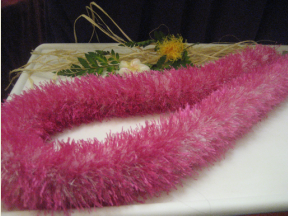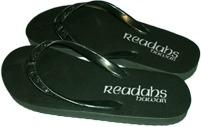Congratulations to the graduating Class of 2010
I realize I’m a bit late on this since several schools have already had their ceremonies, but don’t forget about grad parties folks, you need lots of lei for those too! May through July are the busiest months for local lei makers. Lines are long, flowers are scarce and prices go up. That’s why sometimes it’s easier to do it yourself. If you’re like me and wait til the last minute, it’s easy to feel overwhelmed given the number of lei making books there are out there. And when you’re sitting in your living room at ten o’clock at night with a pile of ribbon and yarn that you’re supposed to turn into a beautiful lei by tomorrow (duck soup right?)…it would be nice to know which book is going to help most in this small kine stressful situation.
My goal was to make leis for graduation AND look at all the lei making books as an average crafter to determine which ones were best for beginners, which ones were best for procrastinators, which ones had the most variety of lei projects and so forth. Not duck soup, here’s why:
- None of the books categorized its projects by skill level. I’m not craft challenged, nor am I an expert but still, I wanna be able to just flip through the book and see which projects are going to be easier and which ones are more challenging.
- None of the books mentioned the average time spent until completion for each project. As a person with very limited free time it’s nice to know which projects are going to be more time consuming than others.
Cook books, and most craft compendiums do include these things and it completely shocked me that not a single lei book deigned it necessary to have. Just because something looks easier or has less materials doesn’t mean it won’t take longer to finish. Those two little bits of information would have meant the world to me as a reader/user trying to decide which lei to make. But I’ve already gone and bought materials, measured and started a lei that’s going to take more time than I have… and if only someone told me ahead of time, I would have made the lei on page 43 instead of page 22.
All the pictures are gorgeous, so you literally want to make them all, which is dangerous for those of us with overactive imaginations and unrealistic notions of time. Pictures and detailed material lists with measurements for ribbon/string length are important details in lei making and I loved that the authors took the time to include those specifics. It was very thoughtful that many also included the Hawaiian names for leis or the names of the artists who created them, and their personal material choices and tool recommendations plus resources for obtaining them. Those were all useful details that still did nothing to help me solve my problem.
In order to do the kind of post I had initially envisioned, I would literally have to make every lei out of every book in order to determine what they should have provided to us in the first place. I just want to help people decide which lei making book might be best for them, not launch a shuttle to the moon. My expose on lei making books is ruined and late because at some point—in a huff of tears, string, hopeless heaving sighs and Alex chuckling out loud within dangerous hearing distance of me (he likes to live on the edge)—I just gave up. This is what I DO have to offer you:
- A stack of lei making books that have driven me to drink.
- ONE straw lei that I ended up asking my Mom how to make anyway.
- ONE braided lei I made from a flashback of high school.
- A receipt for the $75.00 I spent on buying more leis (cuz I was too shame to show up with the two manini ones)
- A massive pile of ribbon that I will eventually use at some point.
- … and this post.
 Hawaiian Seed Lei Making by Laurie Shimizu Ide (Mutual Publishing) is unique because it uses kukui and other seeds. The materials are probably a little harder to obtain—vs ribbon/yarn—but the techniques are rather like bead-working. So if you like beading then this is a nice book to pick up for making lei.
Hawaiian Seed Lei Making by Laurie Shimizu Ide (Mutual Publishing) is unique because it uses kukui and other seeds. The materials are probably a little harder to obtain—vs ribbon/yarn—but the techniques are rather like bead-working. So if you like beading then this is a nice book to pick up for making lei.
Hawaiian Ribbon Leis by Coreen Iwamoto (Mutual Publishing) has better illustrations than the other ribbon lei books below and definitely more variety in terms of technique and materials, so with this one book you could make a nice selection of lei. But some of them do look like they could take awhile.
Hawaiian Shell Lei Making by Laurie Shimizu Ide (Mutual Publishing) is also unique and the tools required to make these type of lei are a bit on the heavier side with drills and sanders for the pukas. This is more of a hobby book rather than a casual lei making how-to and probably great for someone looking to start a side business or make large batches for a halau, and the lei designs are gorgeous!
Hawaiian Lei Making by Laurie Shimizu Ide (Mutual Publishing) is one of the only books on the market that shows you how to make lei with real flowers. This book appears to have a nice selection of easy to make and challenging flower lei without some of the confusing techniques you see with crochet or ribbon leis. And like the rest of her books, Laurie really does show and go “step-by-step”.
Crochet Lei Making in Hawaii (1 & 2) by Judy Dela Cruz (Mutual Publishing) is better organized than the other crochet lei books below and the step-by step photos are SUPER helpful, especially when it comes to crochet. There’s an excellent variety of projects in here including the much easier to do “straw crochet” lei. She expands on the basic “straw crochet” by adding straws to vary thickness, adding different yarns or extra steps to create different looks without complicating the process.
Making Eyelash Crochet Leis (1, 2 & 3) by Coryn Tanaka and May Masaki (Bess Press) have very creative projects—you can’t even tell that these aren’t feathers and flowers! Even with my average crochet skills and their explanations on crochet techniques, the projects are very challenging. This is not a book for beginners and all the projects require the use of crochet hooks, so there’s not much in the way of technique variety. The photo explanations aren’t as detailed as those in Crochet Lei Making in Hawaii (fifth-above), you’re just kind of left to fend for yourself.
Making Ribbon Leis and other Gifts of Aloha by Coryn Tanaka and May Masaki (Bess Press) has more projects in it than Hawaiian Ribbon Leis (second-above) but the variety is a bit lacking and again there aren’t as many photos included in the “step-by-step” directions.
Money Lei Making (1 & 2) by Laurie Shimizu Ide (Mutual Publishing) is really a fun book. It mixes origami with basic lei building so the projects aren’t too challenging and the results are still cute. You won’t have beautiful crochet or ribbon leis like you’d get with the others, but the book has nice variety and creative use of materials. It’s good for beginners and would probably the best one to do with kids, you just have to make sure you can go to the bank and get some clean bills.

It’s nice to have lei around since, living in Hawaii, you never know when you might need one. We give lei for so many reasons and sometimes just because. It’s true that no matter how it’s made or what it looks like, giving a lei is special. Out of all the books I looked at that are readily accessible, I would probably pick Crochet Lei Making, Money Lei Making and Hawaiian Lei Making to keep on hand for any lei making necessities. Hopefully future lei books will include difficulty levels and time approximations to curb any unnecessary emotional distress. When they do, those will be the books that I heartily recommend.

Finished pink "straw crochet" lei




